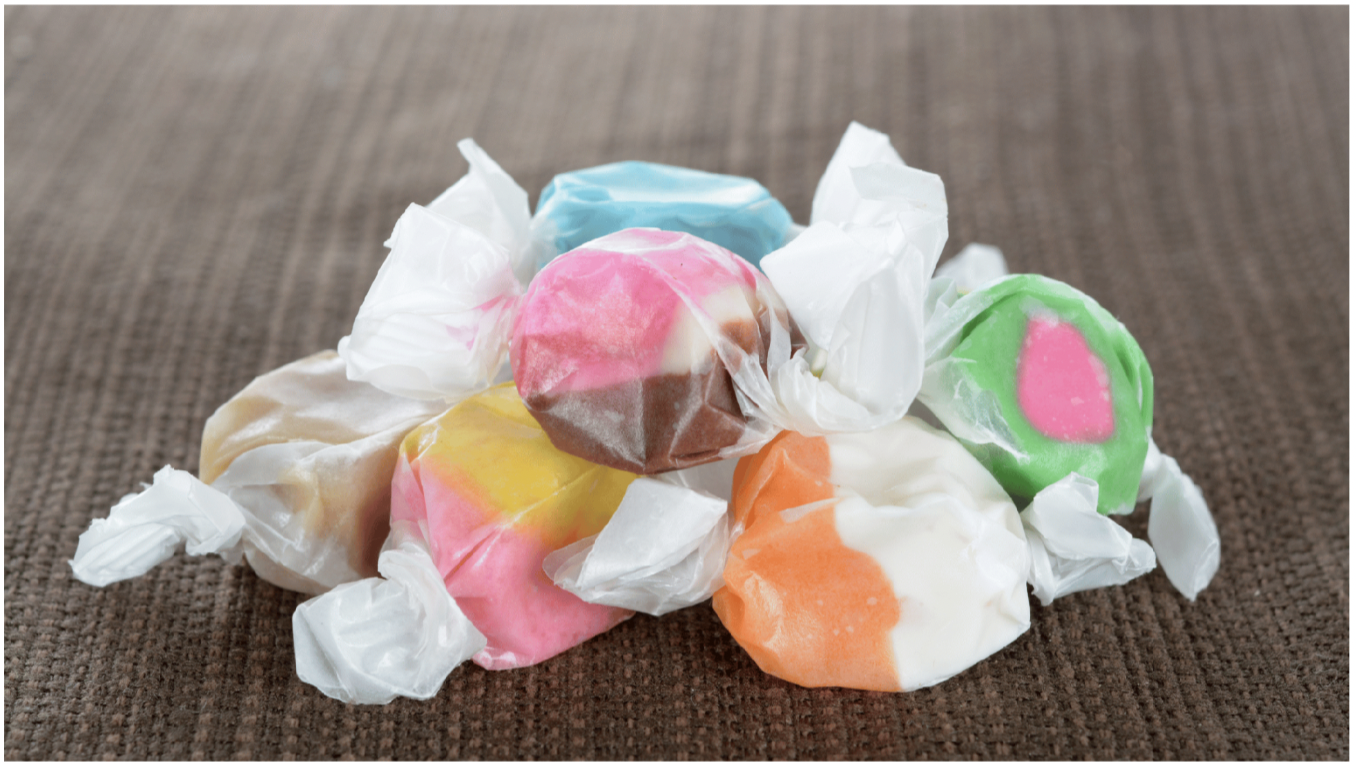Sugar-Free Taffy: Sweet Treats for Health-Conscious Snackers

Curious about enjoying sweet treats without the sugar? Sugar-free taffy offers the perfect solution for those looking to savor the classic candy experience without the sugar and its associated health concerns. Whether you're on a diet or managing conditions like diabetes, sugar-free taffy provides a delightful alternative that doesn't compromise on taste.
Consumers have become more health-conscious and there is a growing demand for sugar-free options. This change has paved the way for innovations like sugar-free taffy, which mimics the texture and flavor of traditional taffy but uses natural and artificial sweeteners.
Selecting the right sugar-free taffy involves understanding its ingredients and how it is made. Not all sugar-free candies are created equal; quality and taste can vary.
Key Takeaways
- Sugar-free taffy is a tasty, diabetic-friendly candy.
- There is a growing demand for healthier, sugar-free options.
- Ingredients matter when choosing quality sugar-free taffy.
The Growing Demand for Sugar-Free Options
Sugar-free taffy mix is gaining popularity. Consumers are becoming more health-conscious. Many are on the lookout for snacks without added sugar.
Parents are opting for sugar-free treats for kids. This helps manage sugar intake. Schools are also promoting these healthier alternatives.
Diabetics need low-sugar choices. Sugar-free taffy fits their dietary restrictions. It allows them to enjoy sweets without health risks.
Fitness enthusiasts appreciate sugar-free snacks. These can lower calorie intake. Athletes and those on specific diets find them beneficial.
Retailers see an increase in demand. Sugar-free products occupy more shelf space. Online marketplaces are also expanding their offerings.
Some prefer sugar-free for its taste. Manufacturers are improving flavors. This makes sugar-free taffy more appealing to a wider audience.
Sugar substitutes like stevia and monk fruit are popular. They provide sweetness without calories. This appeals to diet-conscious consumers.
Awareness about sugar-related health issues is rising. Campaigns and studies highlight the risks. This drives the shift towards sugar-free options.
The market for sugar-free products is diverse. It includes candies, beverages, and baked goods. Innovation in these areas meets the growing demand.
The shift towards sugar-free is not just a trend. It's a response to a lifestyle change. Consumers seek healthier and more balanced choices.
What Is Sugar-Free Taffy?
Sugar-free taffy is a type of chewy candy made without traditional sugar.
Instead of sugar, it uses sugar substitutes like xylitol, sorbitol, or stevia. These alternatives provide sweetness without the calories or glycemic impact of regular sugar.
People who are diabetic or watching their sugar intake often prefer sugar-free taffy.
It is made through a process similar to regular taffy. Ingredients are heated and pulled to achieve a soft, chewy texture.
The end product retains the familiar taste and texture that candy lovers enjoy, minus the sugar.
Flavors are varied and can include fruit, mint, chocolate, and more.
This makes sugar-free taffy a versatile treat for those looking to avoid sugar.
Health Benefits of Sugar-Free Taffy
Sugar-free taffy offers a tasty treat without the added sugar. This is particularly beneficial for those with diabetes. It allows them to enjoy something sweet without worrying about blood sugar spikes.
Low-Calorie Option: Many sugar substitutes have fewer calories than traditional sugar. This makes sugar-free taffy a good choice for those looking to cut calories.
Dental Health: Sugar-free taffy doesn't contribute to tooth decay. Traditional sugary treats can lead to cavities and other dental issues.
Weight Management: Cutting out sugar helps control weight. Sugar-free taffy allows for indulgence without added pounds.
Sugar-free sweeteners like stevia, erythritol, and xylitol are often used. They don't just cut down sugar but also have low glycemic indexes. This is valuable for maintaining stable blood sugar.
|
Traditional Taffy |
Sugar-Free Taffy |
|
High in sugar |
Low or no sugar |
|
Contributes to cavities |
Better for dental health |
|
Higher calories |
Lower in calories |
Overall, sugar-free taffy offers sweet enjoyment with fewer negative health impacts commonly associated with sugar.
Artificial Sweeteners vs. Natural Sugar Alternatives
Artificial sweeteners like aspartame and sucralose have been popular for years. They offer sweetness without the calories. These sweeteners are often found in drinks, candies, and desserts.
Natural sugar alternatives, such as stevia and monk fruit, are derived from plants. They also provide a sweet flavor, but come from natural sources. Some people prefer these due to their natural origins.
Comparison Table:
|
Feature |
Artificial Sweeteners |
Natural Sugar Alternatives |
|
Source |
Synthetic chemicals |
Plants (e.g., stevia, monk fruit) |
|
Calories |
Zero or very low |
Zero or very low |
|
Common Examples |
Aspartame, Sucralose |
Stevia, Monk Fruit |
|
Perception |
Mixed, some concerns over health effects |
Often seen as healthier |
|
Use in Cooking/Baking |
Yes, but may have aftertaste |
Yes, often preferred for natural taste |
Consumers may have health concerns regarding artificial sweeteners. Some studies suggest links to health issues, though more research is needed. Natural sugar alternatives usually don’t face these criticisms as much.
Taste can be a decisive factor. Artificial sweeteners sometimes leave a bitter aftertaste. Natural alternatives like stevia and monk fruit generally have fewer taste complaints.
Both options can fit into a sugar-free diet. Each has its pros and cons. The choice depends on individual preferences and dietary needs.
How Sugar-Free Taffy Is Made
Sugar-free taffy starts with a sugar substitute. Popular substitutes include stevia, erythritol, and maltitol.
The ingredients are combined in a large pot. They're cooked at high temperatures until they reach a malleable consistency.
Once the mixture thickens, flavorings and colorings are added. These give the taffy its unique taste and appearance.
Next, the hot mixture is poured onto a cooling surface. It's allowed to cool briefly before being handled.
The cooled mixture is then pulled and stretched. This process incorporates air, making the taffy chewy and smooth.
Once it reaches the perfect texture, the taffy is cut into smaller pieces. Each piece is wrapped individually to maintain freshness.
Key steps:
- Mix sugar substitute with other ingredients.
- Cook at high temperatures.
- Add flavorings and colorings.
- Pour and cool the mixture.
- Pull and stretch the taffy.
- Cut and wrap.
This method ensures a tasty and enjoyable sugar-free treat.
Sugar-Free Taffy Flavors and Variations
Sugar-free taffy offers a range of flavors to please any palate. Classic options like vanilla, chocolate, and caramel provide a nostalgic experience without the sugar.
Fruit flavors are popular among sugar-free taffy enthusiasts. Strawberry, blueberry, apple, and grape burst with natural taste.
For those who enjoy more adventurous flavors, options like watermelon, banana, and pear are available. The sugar-free versions keep the taste vibrant.
Mint and citrus flavors like peppermint and lemon offer a refreshing variant. They serve as a good palate cleanser.
Mixed packs offer a variety of flavors in one bag. This allows for a delightful assortment in every bite.
Some brands even offer seasonal flavors such as pumpkin spice or eggnog. These limited editions are perfect for festive occasions.
Here is a quick table summarizing common flavors:
|
Classic Flavors |
Fruity Flavors |
Refreshing Flavors |
Adventurous Flavors |
|
Vanilla |
Strawberry |
Peppermint |
Watermelon |
|
Chocolate |
Blueberry |
Lemon |
Banana |
|
Caramel |
Apple |
Pear |
|
|
Grape |
Sugar-free taffy caters to diverse tastes. The varied range ensures there's something for everyone.
Taste and Texture Comparison
Sugar-free taffy offers a unique experience in both taste and texture when compared to traditional taffy.
Taste
Traditional taffy boasts a rich, sweet flavor due to its high sugar content. On the other hand, sugar-free taffy uses sugar substitutes like Stevia, Xylitol, or Aspartame to achieve sweetness. Some individuals might notice that sugar-free taffy has a slightly different aftertaste, especially when consumed in large quantities.
Texture
Texture is another critical point of comparison. Regular taffy has a smooth, stretchy consistency that melts in your mouth. Sugar-free taffy may have a slightly firmer texture due to the absence of sugar crystals, which contribute to its traditional chewiness.
Visual and Tactile Differences
|
Aspect |
Traditional Taffy |
Sugar-Free Taffy |
|
Sweetness Level |
High |
Comparable but varied |
|
Aftertaste |
Minimal |
Potentially noticeable |
|
Consistency |
Smooth and stretchy |
Slightly firmer |
People who are accustomed to the feel of regular taffy might find sugar-free alternatives a bit different at first. However, many quickly adapt and appreciate the healthier benefits while still enjoying a similar experience.
Popular Flavors
Both types of taffy come in a variety of flavors, from vanilla to watermelon and chocolate. The sugar substitutes used do not hinder the infusion of these exciting flavors, making sugar-free taffy a strong contender in the candy market.
Ideal Consumers of Sugar-Free Taffy
Sugar-free taffy appeals to various groups of people.
Those managing their sugar intake due to diabetes find it a great alternative. They can enjoy a sweet treat without worrying about blood sugar spikes.
Weight watchers appreciate that sugar-free taffy adds flavor without the extra calories. It fits well into low-calorie or low-carb diets.
Parents seeking healthier options for their children also favor sugar-free taffy. It allows kids to enjoy candy without the numerous sugar-related health concerns.
Those with dental concerns benefit too. Sugar-free taffy reduces the risk of cavities and other dental issues, making it a dentist-approved choice for candy lovers.
Individuals with specific dietary restrictions also find sugar-free taffy appealing. It’s often free from gluten and artificial additives, catering to various dietary needs.
Pairing Sugar-Free Taffy with Other Foods
Sugar-free taffy can be a delightful addition to a range of snacks and dishes.
Fruit Platter: Pairing sugar-free taffy with a variety of fresh fruits adds an exciting twist. The natural sweetness of fruits like strawberries, apples, and grapes pairs well with the chewy texture of the taffy.
Cheese Board: For a unique combination, try adding sugar-free taffy to a cheese board. Its sweetness contrasts nicely with a variety of cheeses. Soft cheeses like Brie or creamy goat cheese work particularly well.
Nuts and Seeds: A mix of nuts and seeds can enhance the experience of sugar-free taffy. The crunchiness of almonds or cashews complements the chewy texture of the taffy.
- Nuts: Almonds, Cashews
- Seeds: Pumpkin seeds, Sunflower seeds
Beverages: Sip on a refreshing drink while enjoying sugar-free taffy. Consider options like herbal tea, black coffee, or sparkling water. These beverages cleanse the palate and balance the taffy's sweetness.
Yogurt: Adding pieces of sugar-free taffy to a bowl of yogurt can create a satisfying dessert. Greek yogurt's tanginess is particularly a good match. Top it off with some berries for added flavor.
Ice Cream: For an indulgent treat, mix sugar-free taffy pieces into vanilla or chocolate ice cream. The taffy adds a chewy element to the creamy dessert, making each bite interesting.
Sugar-free taffy is surprisingly versatile. It can be enjoyed in various combinations without overwhelming the palate.
Shelf Life and Storage Tips
Proper storage is crucial to maintain the freshness and flavor of sugar-free taffy. They should be kept in a cool, dry place, ideally in taffy thank you bags.
Keep away from heat: High temperatures can cause the taffy to melt and become sticky. Store them at room temperature, ideally between 60-70°F.
Use airtight containers: To prevent taffy from hardening, place them in airtight containers or resealable plastic bags.
Avoid humidity: Moist environments can make taffy sticky and less enjoyable to eat. Keep them in a dry area to maintain texture.
Freezing option: For longer storage, sugar-free taffy can be frozen. Wrap individual pieces in wax paper and place them in a freezer-safe bag.
By following these tips, one can enjoy their sugar-free taffy for an extended period.
Finding Quality Sugar-Free Taffy
For those seeking quality sugar-free taffy, ingredients are crucial. Look for products sweetened with natural alternatives like stevia or xylitol. These substitutes offer sweetness without the added calories of sugar.
Check online reviews before purchasing. Websites like Amazon and Yelp provide customer feedback which can guide your decision. Pay attention to comments about taste and texture.
Visit specialty stores that focus on sugar-free or diabetic-friendly products. Whole Foods, Trader Joe's, and many local health food stores often carry a variety of options. They may even offer samples, which lets you taste before committing.
Here’s a quick list to consider:
- Natural Sweeteners (stevia, xylitol)
- Customer Reviews (Amazon, Yelp)
- Specialty Stores (Whole Foods, Trader Joe's)
- Tasting Samples (if available)
Quality packaging also plays a role. Look for taffy that is individually wrapped to maintain freshness. Additionally, make sure the packaging is sealed properly to ensure the product inside is protected from moisture and contamination.
Finally, try smaller amounts first. Buying in bulk can be tempting, but it's better to taste various brands and flavors to find what you like best. This prevents wastage and ensures you enjoy your sugar-free treat.
Finding the right sugar-free taffy involves some research and trial and error. By considering ingredients, reviews, store options, packaging, and sampling, you can find the perfect sweet treat without the sugar.






